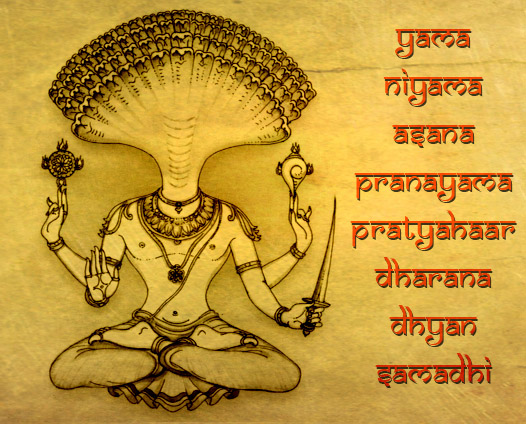Patanjali Yog Sutras

Patanjali Yogsutras are an encyclopaedia on human behaviour and psychology. There is no aspect of a human being, which is not touched or explained and evaluated. The mind is so beautifully explained that it amazes when one wonders... all this 5000 years back??!
They give not just explanations but also solutions to all human maladies and fears... just that we should have a developed mind to understand them and not interpret them as a physical exercise. They explain the complete being and his various levels of existences and how to go beyond... practically.
In order to follow them, one has to do away with ego and a false superiority complex.
They explain God and sources of human maladies and how to reach Him and do away with them.
A very practical knowledge and gyan... ideal for the human of today... But of course, ego has to be forgotten when practicing them... only through a Guru.
An Overview of Patanjali Yog SutrasPatanjali Yog Sutras are divided into four padas or parts,
- Self is pure consciousness, beyond the limitations of mind and body, but in its ignorance it confuses itself with the chitta and gets tied to the pleasures, pains and experiences of the physical body and appears to pass through 'states of mind' or 'stages of life'.
- The aim of yog is union with self, free from the mind and body and their related experiences, all of which are temporary and destructible.
- This calls for intense sadhna and one-pointed focus, ie, yogah ek tatva nirantar abhyasa. **
These days yog is mistaken as a means to improve physical life and solve physical problems - to cure disease, to gain health, to grow financially or mend relationships... from the above, one can be amply sure that the purpose of yog is take you beyond the physical and related pleasures and not to tie you more into it. If anywhere in the world one is promising all these in the name of yog, be rest assured what is being offered is not yog.
- pramana - true cognition in the form of perception, inference and testimony
- viparyaya - wrong cognitions, uncertain cognitions and doubts
- vikalpa - verbal ideas created by words that correspond to no real facts
- nidra - sleep
- smriti - memory and past experiences
**There are five levels of mental life (chittabhumi) determined by the relative dominance of sattva, rajas and tamas
- ksipta - restless state, rajas and tamas dominate, mind is attracted to sensory pleasures and means of attaining power.
- mudha - torpid state, pre-dominance of tamas, mind tends towards vice, ignorance, sleep, etc.
- viksipta - distracted state, predominance of rajas, mind has tendency towards virtue, knowledge however it is a state of temporary concentration followed by distraction.
- ekagra - concentrated state, there is manifestation of sattva, mind is able to concentrate on any object for prolonged times to reveal its true nature - preparatory stage for cessation of modifications of mind.
- niruddha - restrained state, predominance of sattva, cessation of all mental functions including concentration, leaving the mind in its original ripple-less state.
- sampragyat samadhi - mind is focused on an object and assumes the form of that object.
- asampragyat samadhi - nothing is known or thought by the mind
- Most people relate to yog as asanas, which are understood as complicated twists and turns of the body. You will be surprised to know that there is no mention of any such postures in the Patanjali Yog Sutras. There is just one description, which is, 'sukham sthiram asanam', that is a state of comfort, stillness and stability. Patanjali is obviously not talking about the physical body as perceived by normal beings. He is talking about subtler and deeper aspects of consciousness from where one may affect a change in the physical.
- By now, it is clear yog is not about physical exercise, neither is it about abnormal breathing techniques often, misunderstood as pranayam. The only pranayam mentioned in the yogsutras is kumbhak, that is, cessation of breath and that too not forced, but natural cessation upon entering a state of stillness.
- Ashtang Yog as given by Sage Patanjali is like an eight-limbed chair, if any of the limbs is missing the person who sits on it will be unstable. Therefore it is imperative to practice the eight limbs in totality and in an undiluted form under the guidance of a Guru who gives (and not sells) you the gyan of the deeper and subtler aspects, which is beyond the comprehension of your limited brain functions.
* Under the influence of modifications of mind, the self appears to be concerned with bodily functions as well as the five kleshas,
- avidya - incorrect knowledge of non-eternal as eternal, impure as pure, non-self as self
- asmita - false notion of self as buddhi or mind
- raga - desire for pleasure and means to attain it
- dvesha - aversion to pain and its causes
- abhinivesha - instinctive fear of death
-As one walks the path of Ashtang Yog holding the hand of Guru, he is blessed with certain siddhis or spiritual powers at different stages of sadhna - manifestation of speech and thoughts, supernatural sights, sounds and fragrances, interactions with subtler energies, access to dimensions of past, present and future, clairvoyant abilities etc. In fact, the first five siddhis of Ashtang Yog lie in the first limb, yamas. However the yog sutras warn a sadhak not to take up practices for the lure of siddhis because they are not ends in themselves. They are there to aid a sadhak on this ultimate journey of spirit. If one gets swayed by the newly acquired siddhis, there is a strong chance of getting stuck and losing sight of your path
It is amazing that when the world was thought to be inhabited by barbarians, a sage in the Himalayas had mastered the science of being and gave us such advanced scientific concepts which are yet to be paralleled by modern science.
Patanjali gave to the world the deepest secrets of creation, the subtlest aspects of being. The world is now missing the essence and trying to buy what they understand, which is the physical - the mind and body, funny postures and breathing exercises, solutions to their physical problems - missing out completely on the essence of the yog sutras. Even those who are teaching are not practicing what they preach and have reduced the sutras to a mere theory, a ground on which they can run their business houses and earn name, fame and money for themselves. Because they know no better, as there is no Guru to show them the truth, to give them the experience of the subtler aspects and higher pleasures that exist beyond the physical world.
Guru is a must for he/she would reveal to you the gyan...not sell it to you.
Reading texts merely satiates the intellect, because what is reading and understanding is the brain or the mind, and that itself is physical and destructible. To access the eternal, to experience phenomenal power of yog, it is imperative to still the mind and this is only possible through gyan or experience, which is the domain of Guru. Ram and Krishna also made Gurus, even when they were God.
Signs of a Guru
- A Guru exudes what he talks. He practically experiences and radiates the phenomenal glow and attraction that is associated with the state. When you are in the presence of your Guru, you experience the same attraction within you and feel healthy and glowing.
- A Guru is above the attractions of the five senses; he desires nothing in the physical world, yet can achieve anything by just a thought. He is in a state of vairagya. When you meet your Guru, you experience the same vairagya within you.
- When you hold the hand of your Guru, truths of creation are revealed to you. You start experiencing and interacting with energies that run the creation.
- A Guru is like a mirror for you. He will not try to impress you or do sweet talk. He will make you see your truth so that you may rise above.
Beware of…
- Conmen demanding financial, material, political or sexual favors in the name of teaching yog. Anyone who is tied by the pleasures of five senses cannot release you from the clutches of maya, which is the ultimate purpose of yog.
- Businessmen who try to lure you with innovative cures and ways to fulfil your physical desires in the name of yog to keep their businesses running. The purpose of yog is to move beyond the physical, not to tie you more into it.
- Frauds who make promises of glow and attraction but themselves do not exhibit these signs. Be sure of what to follow, because after sometime you will look just like that. If you follow a yogi, you will radiate his glow. If you follow a monkey, you will end up dancing around trees…
Yog is the final frontier. Hence, get over the attractions of life through a Guru and then go beyond.
For greater insight into the patanjali yogsutras, contact Dhyan Foundation
